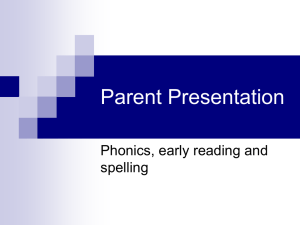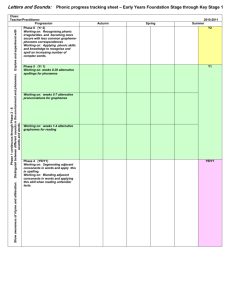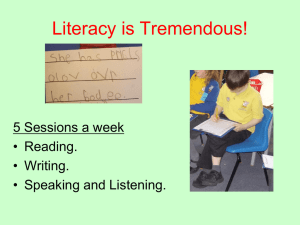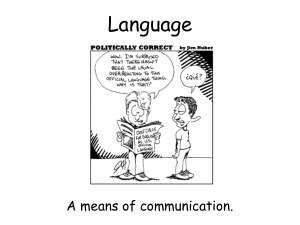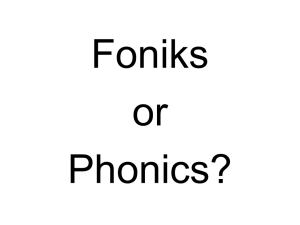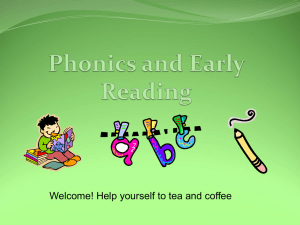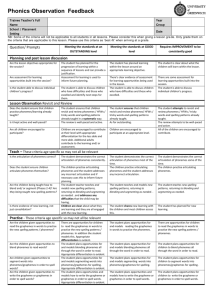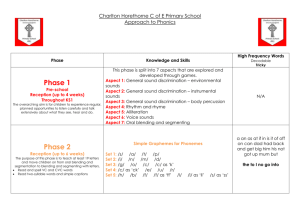Staff Meeting Spelling through School
advertisement
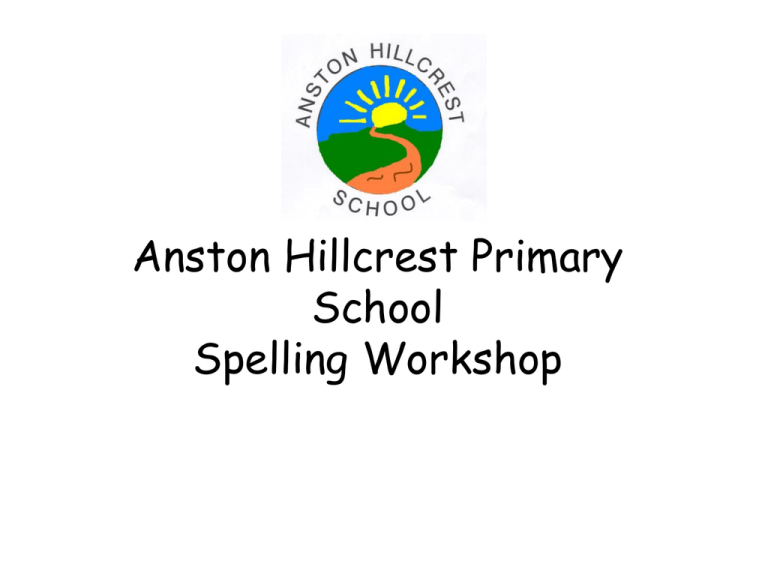
Anston Hillcrest Primary School Spelling Workshop Aims • • • • How we teach spelling in school Spelling strategies Games What you can do at home? Spelling.. a ‘peace’ of cake? • Linked to self esteem • Specific difficulties • Only taught phonemes marked Phonics Teaching in FS & KS1 • • • • • 15 minutes a day Every single day At the appropriate phase for the children Y2 10 words per week Learning environment Fast Fun Systematic Timetable for Expected Phases Phase 1: FS1 Phase 2: Starts FS2 (6 weeks) Phase 3: Starts FS2 (Oct 12 weeks) Phase 4: FS2 (4-6 weeks) Phase 5: Starts Y1 (1 Year) Phase 6: Starts Y2 (1 Year) 44 Phonemes Terminology • A phoneme is the smallest unit of sound in a word • A grapheme is the letter, or letters, representing a phoneme t ai igh Terminology Two letters, making one sound A consonant digraph contains two consonants sh ck th ll A vowel digraph contains at least one vowel ai ee ar oy Three letters making one sound igh dge Terminology Split Digraphs A digraph in which the two letters making the sound are not adjacent, (e.g. make) Segmenting • Segmenting • Chopping up the word to spell it. t a p Phoneme frames sh o p Segmenting shelf = sh – e – l – f = 4 phonemes dress = d - r - e – ss = 4 phonemes sprint = s – p – r – i – n – t = 6 phonemes string = s – t – r – i – ng = 5 phonemes Phase 1 • Exploring and experimenting with sounds and words • Distinguish between different sounds in the environment and phonemes • Learn to orally blend and segment words Phase 2 • 19 phonemes and graphemes • VC and CVC words • 2 syllable words, simple captions and some tricky words. s a t p i n m d g o c k ck e u r h b f ff l ll ss the to no go I Phase 3 • Next 25 phonemes and graphemes • Learn letter names • New phonemes and 2 syllable words. j v w x y z zz qu ch sh th ng ai ee igh oa oo ar or ur ow oi ear air ure er Phase 3 • Be able to blend and read CVC words • (i.e. single-syllable words consisting of Phase Two and Phase Three graphemes) e.g. cheep tooth chair sharp north coach shock thorn light yurk quoam zort Reversibles • • • • pat snip strap ward Anna Hannah tap pins parts draw Palindromes! Finish st___ p 20 seconds to complete the word. stamp stoop strip steep strap stop ‘ur’ ‘er’ ‘oi’ surpise urgent purchase furniture purpose Word Blocks stop s t p a o l b m r stab stamp star lamp Phase 4 • Consolidation • Consonants and polysyllabic words. (CCVC, CVCC, CCVCC) Step list clap grasp strap Tricky words the to I no go he she we me be was my you her they all are Word Ladders Rhyme it Helps tune the children into listening carefully. Sick Stick Choose ea / ee / e consonant e Meat seat treat heat complete sleet Right from Wrong Children identify the correct version of the spelling. Tomorrow Tommorow Tomoro Phase 5 • Broaden knowledge of graphemes and phonemes • Learn new graphemes and alternative pronunciations. • Choosing appropriate graphemes when spelling and begin to build up word specific knowledge. Phase 5 New graphemes ay (day) oy (boy) wh (when) a-e (make) ou (out) ie (tie) ea (eat) ir (girl) ue (blue) aw (saw) ey (honey) ph (photo) ew (new) oe (toe) au (paul) e-e (these) i-e (like) o-e (home) u-e (rule) Phase 5 – Alternative pronunciations a: hat acorn fast was e: bed he i: tin find o: hot no u: but unit pull ow: down low ie: pie field ea: sea head er: fern farmer ou: out soup could mould y: yes my gym happy ch: chin chef school c: cat cell g: got magic ey: they money Speed Write Write the word out as many times as possible within 30 seconds. Muscle memory Phase 6 Spelling • Identify tricky bits in a word. • Develop strategies for spelling longer words. • Develop guidelines for making choices between spelling alternatives. • Begin to explore spelling conventions e.g. when using past tense, adding suffixes. What’s the rule? Move – moving Shove – shoving Change – changing Remove the ‘e’ and add ‘ing’ Hop – hopping Slip – slipping Tap – tapping Step – stepping Double the final consonant after a short vowel sound and add ‘ing’ Hangman Spelling Strategies • Colour phonemes • Counting letters of challenging spellings • Splitting the word into syllables / phonemes Sep a rat e separate • Look for words within words / word families. • Knowledge of prefixes and suffixes • Mnemonics because • Big elephants can always understand small elephants How to support your child? • Practise spellings and have fun with words. • Find the tricky bits and work on that. • Read as much as possible to and with your child. • Encourage and praise – get them to have a "good guess! • Ask your child’s teacher if you want to know more. Useful Websites http://www.phonicsplay.co.uk/index.htm http://www.topmarks.co.uk/EducationalGames.aspx http://www.familylearning.org.uk/phonics_games.html http://www.bbc.co.uk/schools/wordsandpictures/index.shtml http://www.funbrain.com/kidscenter.html
